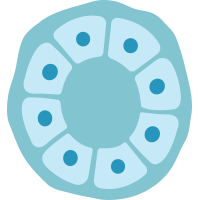
Mammary Cell News
Mammary Cell News is an online resource covering the latest research into breast cancer and mammary cells.
CREPT is required for the metastasis of triple-negative breast cancer through a co-operational-chromatin loop-based gene regulation.
[Molecular cancer] Researchers reported that CREPT/RPRD1B, which exhibits somatic gene copy-number amplifications and elevated expression, correlated with poor patient survival and drives TNBC metastasis.
Multi-Omics Analyses of the Heterogenous Immune Microenvironment in Triple-Negative Breast Cancer Implicate UQCRFS1 Potentiates Tumor Progression.
[Experimental Hematology & Oncology] Scientists offered innovative perspectives on comprehending the heterogeneity within the TME of TNBC, thereby facilitating the elucidation of TNBC biology and providing clinical recommendations for TNBC patients' prognosis, such as IL32high Treg infiltration, Malignant Cell Index evaluation, and UQCRFS1 expression.
Nanoscale Structural Dynamics of Cell Edges in Breast Tumor Cells Revealed by Scanning Ion Conductance Microscopy.
[Nanoscale] Researchers utilized time-lapse scanning ion conductance microscopy to visualise subcellular nanoscale structural dynamics at the edges of breast cancer cells.
An Antibody-Photosensitiser Bioconjugate Overcomes Trastuzumab Resistance in HER2-Positive Breast Cancer.
[European Journal of Medicinal Chemistry] Investigators explored the use of photodynamic therapy with a trastuzumab-IRDye700DX photoimmunoconjugate as a strategy to overcome trastuzumab resistance.
Novel Chloropyridazine Sulfonamides As Aromatase Inhibitors and Apoptotic Inducers in Breast Cancer.
[Bioorganic Chemistry] Scientists combined sulfonamide, chloropyridazine, and pyrrole in a single design as potential aromatase inhibitors for breast cancer.
Integrating PET/CT into Breast Cancer Care: A Review of Recent Developments
[Expert Review of Anticancer Therapy] The authors explore the role of PET/CT in breast cancer (BC) management and emerging radiotracers for enhanced diagnosis. They examine how 1 8 F-FDG-PET/CT findings are influenced by BC classifications such as histopathological type, grade, receptor status, and stage.
Arvinas Announces Submission of New Drug Application to US FDA for Vepdegestrant for Patients with ESR1-Mutated ER+/HER2- Advanced or Metastatic Breast Cancer
[Arvinas, Inc.] Arvinas, Inc. announced the submission of a New Drug Application to the US FDA with its partner Pfizer Inc., for vepdegestrant for the treatment of patients with ER+/HER2- ESR1-mutated advanced or metastatic breast cancer previously treated with endocrine-based therapy.
KDM4C Inhibition Blocks Tumor Growth in Basal Breast Cancer by Promoting Cathepsin L-Mediated Histone H3 Cleavage
[Nature Genetics] Scientists described a unique role for the KDM4C histone lysine demethylase in KDM4C-amplified basal breast cancers, where KDM4C inhibition reshapes chromatin and transcriptomic landscapes without substantial alterations of its canonical substrates, trimethylated histone H3 lysine 9 and lysine 36.
Cancer-Associated Fibroblasts Serve As Decoys to Suppress NK Cell Anticancer Cytotoxicity in Breast Cancer
[Cancer Discovery] Using mouse models of breast cancer and ex vivo cocultures, researchers found that cancer-associated fibroblasts inhibit natural killer cell cytotoxicity toward cancer cells.
Dynamic Regulation of Integrin β1 Phosphorylation Supports Invasion of Breast Cancer Cells
[Nature Cell Biology] Investigators engineered a fluorescence resonance energy transfer biosensor for integrin β1 phosphorylation, screening 96 protein tyrosine phosphatases and identifying Shp2 and PTP-PEST as negative regulators to address this gap.
High Prevalence of Constitutional BRCA1 Epimutation in Patients with Early-Onset Triple-Negative Breast Cancer
[Clinical Epigenetics] Scientists assessed BRCA1 epimutation prevalence in a large cohort of 112 early-onset (≤ 30 years-old) TNBC patients with no genetic cancer-predisposing pathogenic variants
Exosomal POU5 F1 Derived from TNBC Promotes Cancer Progression by Regulating M2 Macrophage Polarization via Inhibiting TRAF6 Ubiquitination and Activating AKT in Macrophage
[Cell Biology and Toxicology] Researchers revealed a significant enrichment of the POU domain, class 5, transcription factor 1 (POU5F1) in TNBC cells-derived exosomes.
For over a decade, Mammary Cell News has been keeping the global scientific and medical communities informed about the latest research, reviews, and news in the field of mammary tissues. Our editors gather publications on the topic of mammary cell differentiation and characterization, as well as the progression and treatment of breast cancer. We also keep scientists up-to-date on the latest policy changes, job postings, and events.

 Cancer Stem Cell News
Cancer Stem Cell News Cell Therapy News
Cell Therapy News Dermal Cell News
Dermal Cell News Endothelial Cell News
Endothelial Cell News ESC & iPSC News
ESC & iPSC News Extracellular Matrix News
Extracellular Matrix News Hematopoiesis News
Hematopoiesis News Hepatic Cell News
Hepatic Cell News Human Immunology News
Human Immunology News Immune Regulation News
Immune Regulation News
 Intestinal Cell News
Intestinal Cell News Mammary Cell News
Mammary Cell News Mesenchymal Cell News
Mesenchymal Cell News Muscle Cell News
Muscle Cell News Neural Cell News
Neural Cell News Organoid News
Organoid News Pancreatic Cell News
Pancreatic Cell News Prostate Cell News
Prostate Cell News Pulmonary Cell News
Pulmonary Cell News
